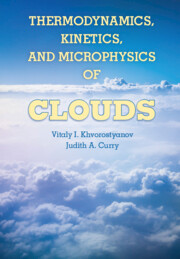Book contents
- Frontmatter
- Contents
- Preface
- 1 Introduction
- 2 Clouds and Their Properties
- 3 Thermodynamic Relations
- 4 Properties of Water and Aqueous Solutions
- 5 Diffusion and Coagulation Growth of Drops and Crystals
- 6 Wet Aerosol Processes
- 7 Activation of Cloud Condensation Nuclei into Cloud Drops
- 8 Homogeneous Nucleation
- 9 Heterogeneous Nucleation of Drops and Ice Crystals
- 10 Parameterizations of Heterogeneous Ice Nucleation
- 11. Deliquescence and Efflorescence in Atmospheric Aerosols
- 12 Terminal Velocities of Drops and Crystals
- 13 Broad Size Spectra in Clouds and the Theory of Stochastic Condensation
- 14 Analytical Solutions to the Stochastic Kinetic Equation for Precipitating Clouds
- References
- Notations
- Index
9 - Heterogeneous Nucleation of Drops and Ice Crystals
Published online by Cambridge University Press: 05 September 2014
- Frontmatter
- Contents
- Preface
- 1 Introduction
- 2 Clouds and Their Properties
- 3 Thermodynamic Relations
- 4 Properties of Water and Aqueous Solutions
- 5 Diffusion and Coagulation Growth of Drops and Crystals
- 6 Wet Aerosol Processes
- 7 Activation of Cloud Condensation Nuclei into Cloud Drops
- 8 Homogeneous Nucleation
- 9 Heterogeneous Nucleation of Drops and Ice Crystals
- 10 Parameterizations of Heterogeneous Ice Nucleation
- 11. Deliquescence and Efflorescence in Atmospheric Aerosols
- 12 Terminal Velocities of Drops and Crystals
- 13 Broad Size Spectra in Clouds and the Theory of Stochastic Condensation
- 14 Analytical Solutions to the Stochastic Kinetic Equation for Precipitating Clouds
- References
- Notations
- Index
Summary
Introduction
It was shown in the previous chapter that homogeneous nucleation of water drops from vapor becomes effective only at very high supersaturations and homogenous nucleation of ice crystals occurs only at temperatures lower than −35 to −38°C. Nucleation of droplets from vapor occurs at lower supersaturations on the surface of a foreign substrate that has the property of “wettability.” Ice formation occurs at substantially higher temperatures, a few degrees below 0°C, when the ice crystals form on the surface of specific foreign particles termed “ice forming nuclei” (IFN) or simply “ice nuclei” (IN). Nucleation of drops and crystals on the surfaces of foreign substances is called “heterogeneous nucleation.”
Formation of the ice phase in clouds at temperatures warmer than −38°C and small supersaturations via heterogeneous nucleation have been reviewed extensively in previous cloud physics textbooks—e.g., Fletcher (1962), Dufour and Defay (1963), Defay, Dufour, and Bellemans (1966), Young (1993), Pruppacher and Klett (1997), Kashchiev (2000). Heterogeneous nucleation also can act at temperatures colder than −38°C if appropriative ice nucleating aerosols are present, although the relative importance of heterogeneous and homogeneous nucleation at these colder temperatures is less clear (e.g., Sassen and Dodd, 1988, 1989; DeMott et al., 1998, DeMott, 2002; Lin et al., 2002; Khvorostyanov and Sassen, 1998a,b,c, 2002; Gierens, 2003; Kärcher and Lohmann, 2003; Khvorostyanov et al., 2006; Barahona and Nenes, 2009; Hoose and Möhler, 2012). Heterogeneous ice nucleation dominates in polar clouds and multilayer frontal and cyclonic cloud systems (frequently observed to be mixed phase), and also in deep convective clouds and anvil cirrus, when large amounts of mixed aerosol particles can be brought into the middle and upper troposphere and may serve as ice nuclei.
- Type
- Chapter
- Information
- Thermodynamics, Kinetics, and Microphysics of Clouds , pp. 395 - 506Publisher: Cambridge University PressPrint publication year: 2014



